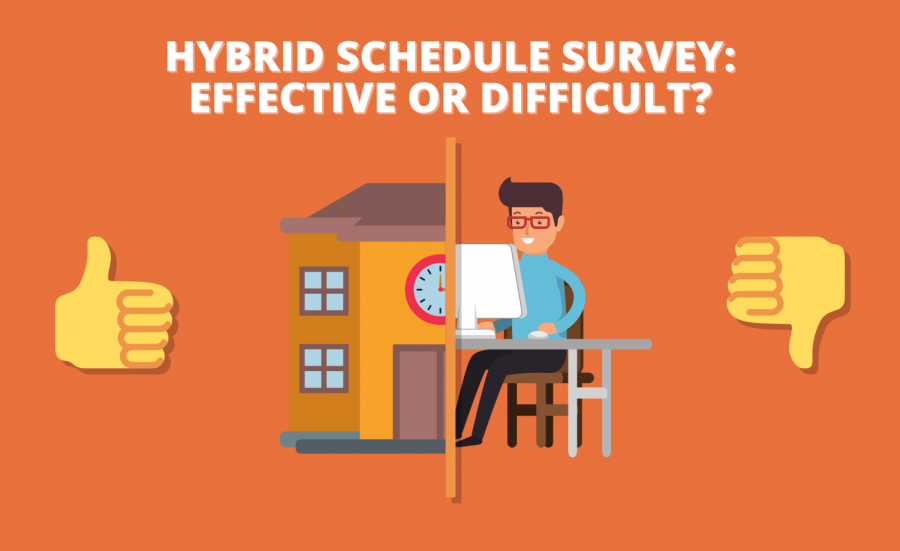The hybrid schedule: Effective or difficult?
Using a public Instagram poll, students were asked the overall question: “Would you say the hybrid schedule is good or bad?”
Using a public Instagram poll, students were asked the overall question: “Would you say the hybrid schedule is good or bad?”
2020 is a first in many things. But with firsts come changes. For the first time, Pascack Hills is operating during a pandemic. For the first time, students are experiencing school under a hybrid schedule. Undoubtedly, as a different schedule, this new system is prone to be accompanied by feedback. So, what do the students think of this schedule?
Using a public Instagram poll, students were asked the overall question: “Would you say the hybrid schedule is good or bad?” Out of the respondents, 59% of the 64 voted “good”, while 41% voted “bad”.
Various points were made by supporters as to why they liked this new schedule. The dominating reason? They had the opportunity to see each other in-person. Since March, no students have experienced the feeling of being inside a classroom among friends. When comparing hybrid to full-remote, the hybrid is as close as they can get to “normal” life.
aDVERTISE HERE
As Hills freshman Jessi Villamarin said, “I like it because it allows us to socialize with people.” Legitimate social interaction is something essential to everyone, especially those in a learning environment. Simply put, they enjoy seeing their friends.
Learning environment
Another point made was that the hybrid schedule is more effective for learning. Many said that their online classes are hard to follow and that they often find themselves confused as to what their assigned work is. Students find being in-person is much more efficient for learning since they can simply ask questions and receive immediate feedback. When asked what they thought about the effectiveness of virtual calls, 84% of the google form respondents agreed that the calls were highly ineffective, and most of their classmates are visibly unengaged.
Hills junior Scianna Scott feels as though “virtual calls are much less effective for learning than in-person teaching because it is so much easier for students to be distracted.”
School-life balance
Furthermore, the hybrid schedule offers something new to the entirety of Hills: a Pascack Period to start or end the day. As you may or may not know, Pascack Period is similar to a free period for students, typically at one specific period. Last year, all of Hills would have this period in the middle of the day each week. Students could catch up on work, talk, and pace themselves accordingly so they feel less overwhelmed.
However, things are run differently this year. Due to Covid-19, too many students in one place at one time is an extreme safety hazard. Instead, depending on your schedule, many students have a Pascack Period either at the start 8:20 a.m. or end 11:20 a.m. of their in-person day. This allows them to arrive later, as long as they’re present for their second class, and leave earlier. This also reduces the number of students exiting the building at one time.
A huge advantage of this new schedule is that students can sleep in, something the majority of us are deprived of. Christina Kim, a Hills senior, stated, “I honestly believe that the Pascack Periods have helped so many students this year. Whether it be getting that extra hour of sleep in the morning, or having some free time to study or do work, it has been so beneficial to many.” The last main pro supporting the hybrid model was that it provides balance to students’ lives. One good thing that has come out of Covid for many, was resting at home. Oftentimes, the combination of activities and work becomes overwhelming.
Riley Solomon, a Hills junior, described how she liked “the balance between in-person days and virtual days. In the past, it was really easy to get burnt out and be so exhausted by school all day, but now it alternates between going to school, and staying at home which makes school less stressful and allows for more relaxation.” Going to school some days while resting and working at your own pace maintains balance. Many found that this is convenient for catching up on work in between classes, reducing stress levels, and creating more comfort for students.
Within the adversaries, their dominating reason was that splitting into two cohorts caused splitting between friend groups. With the way the Hills hybrid model works, Cohort A primarily consists of last names A-K, while Cohort B is for last names L-Z. This was done to avoid overcrowding in the schools so that classrooms could accommodate for social distancing guidelines.
Obviously, not all of your friends just so happen to be included under last names A-K or L-Z. For students, the splitting between their last names means they don’t get to be among their friends on in-person days. And yes, this does matter to students, especially those who keep in close touch with friends. “The only bad thing about it is that friend groups get split up,” said Julia Du, a freshman.
Convenience
A secondary critique many had for this new schedule was its inconvenience. Freshman Josh Mayer, as well as many others, stated that “it makes everything so much more confusing.” Switching back and forth between in-person and remote can be confusing as well as annoying if you participate in other activities. For freshmen who have never had to deal with the original Hills schedule at all, navigating the halls, using Canvas, logging into Genesis for class and the whole routine is confusing as it is; having to adjust to the hybrid model on top of that has presented itself as a struggle.
In the poll, 42% stated that they were still confused with the schedule. For athletes, it’s especially inconvenient to leave the school at 12:15 p.m. just to come back around 3:00 p.m. This is dissimilar from the pre-Covid state of last year where students went to their sports practices and games immediately after school. Regarding Canvas and online work, multiple students complained about how hard it is to identify their assignments as well as their exact instructions, due dates, and other necessary information.
One Hills student, who asked to remain anonymous, said that “as a result of the chaos and disorder and having to memorize where every teacher puts everything and every website that they use and what they use it for, I spent the first few weeks of school missing assignments left and right. And I have to study for the PSAT! I understand that different classes require different resources, but just a little more standardization would be nice.”
Although Pascack Periods posed as a silver lining, they unfortunately do not apply to all students. Out of the poll, 31% of the respondents noted that they “didn’t even get Pascack Periods” as their first or last period in the day, which would allow them to leave early or start late. Some of these students also claimed that the Pascack Periods weren’t the most effective.
The majority of Hills students are slowly adapting to this new way of life. Although this schedule isn’t perfect for each of us, we have to acknowledge that we are still undergoing a pandemic, and to be inside a school is an upgrade to being at home all day. Hills has combined immense efforts to make this year as memorable as possible for us, and it is imperative that we learn to embrace this new norm.

Hills senior Julia Bang is looking forward to being on the Trailblazer for her final year. She joined the publication her freshman year as a staff writer and edited for the Life & Style and In-Depth sections in her sophomore and junior years, respectively. This year, Bang is excited to create content and manage stories alongside the entire editorial staff.
Fun fact: Bang is a "cafe enthusiast."













































